6172RB Science a STEM approach Year 2 low res watermark
Create successful ePaper yourself
Turn your PDF publications into a flip-book with our unique Google optimized e-Paper software.
Earth and space sciences<br />
OUR RESOURCEFUL WORLD<br />
Lesson 1<br />
Lesson plan<br />
Introduction:<br />
1. Play a game of I spy. Choose a natural or man-made object that you can see and give students<br />
clues relating to its use, where it can be found or if it is naturally occuring or man-made. Repeat the<br />
game a few times using different objects. QP PC<br />
2. Explain to students that all of these objects are <strong>res</strong>ources. Resources are materials or objects that<br />
can be used in our everyday lives. Some <strong>res</strong>ources can be found naturally and some need to be<br />
transformed in factories or laboratories to be useable. The <strong>res</strong>ources that can be found naturally are<br />
called Earth’s <strong>res</strong>ources. What natural <strong>res</strong>ources can you think of that we use in our everyday lives?<br />
QP<br />
Development:<br />
3. Watch the video Resources: Welcome to the neighbourhood at .<br />
This video gives a brief overview of Earth’s <strong>res</strong>ources, how communities are built around available<br />
<strong>res</strong>ources and how these are transformed into useable products and energy sources.<br />
4. Display the Earth’s <strong>res</strong>ources brainstorm on page 80 on an interactive whiteboard. Read each<br />
category of Earth’s <strong>res</strong>ources, including air, sun, water, soil, minerals and rocks, plants, and animals.<br />
Discuss that in addition to these <strong>res</strong>ources, fossil fuels, including coal, oil and natural gas, are also<br />
natural <strong>res</strong>ources that have been created by the decomposing matter of prehistoric plants and<br />
animals. Note: These are used as energy sources or transformed in factories into plastics and other<br />
man-made materials, and may be difficult for students to find around the school. For this reason,<br />
fossil fuels have not been included on page 80.<br />
5. Divide the class into pairs and give each pair a digital camera or an iPad® and a copy of page 80.<br />
Conduct a 15-minute school walk where students find examples of how Earth’s <strong>res</strong>ources have<br />
been used around the school. Students list examples of each <strong>res</strong>ource on page 80 and take a<br />
digital photograph of each. PC PA<br />
6. Return to the classroom and ask students to partner up with another pair and share their recorded<br />
information and photographs. Then, using the brainstorm displayed on the interactive whiteboard,<br />
ask students to share their recorded information about how these <strong>res</strong>ources have been used<br />
around the school. Add students’ suggestions to the class brainstorm. Note: Students may be<br />
encouraged to print and attach their digital photographs to the brainstorm. E C<br />
Reflection:<br />
7. Give each student one card, either a ‘Resource’ card or a ‘Use’ card from the pre-prepared cards<br />
on page 81. Without talking, students attempt to form groups to match the Earth’s <strong>res</strong>ource to the<br />
uses of that <strong>res</strong>ource. Note: Depending on class size, students may be given just a ‘Use’ card with<br />
‘Resource’ cards placed in various locations around the room. Students form groups of three at each<br />
‘Resource’ card. When students have formed their groups, encourage them to share the name of<br />
the Earth’s <strong>res</strong>ource and the uses for that <strong>res</strong>ource. PA C<br />
Differentiation<br />
• Less capable students may be given a familiar <strong>res</strong>ource such as sun, air, water, soil/sand, plants<br />
or animals. For students who need further support, a <strong>res</strong>ource card from column one or an<br />
easily-identifiable ‘Use’ card, such as those listed in column two on page 81 may be used<br />
instead.<br />
• More capable students may be given a less-familiar <strong>res</strong>ource, such as minerals or fossil fuels, or<br />
be given a more challenging ‘Use’ card, such as those listed in column four on page 81.<br />
© R.I.C. Publications<br />
Low <strong>res</strong>olution display copy<br />
R.I.C. Publications® – www.ricpublications.com.au 978-1-925431-95-7 YEAR <strong>Science</strong>:<br />
2 A <strong>STEM</strong> APPROACH 79


















